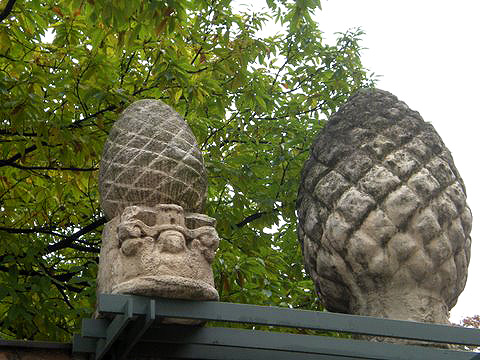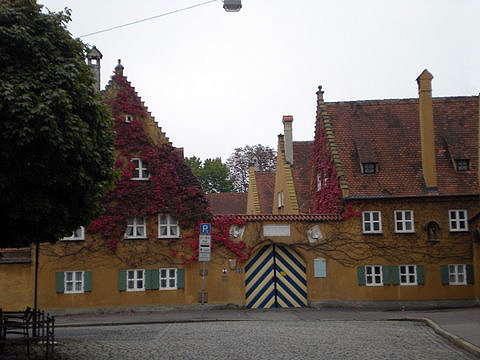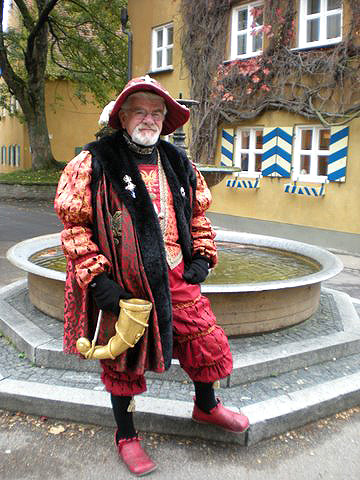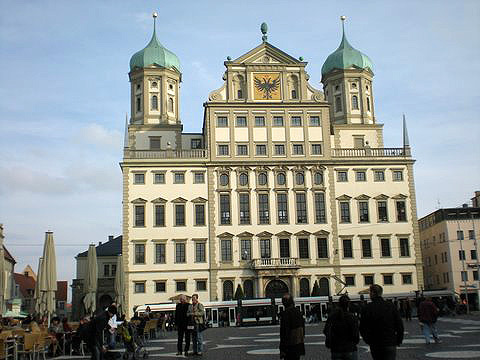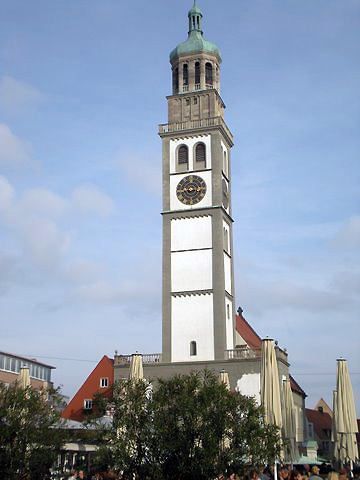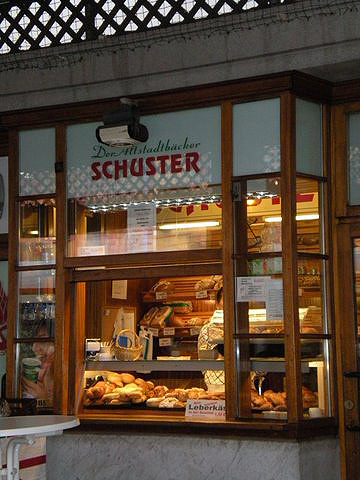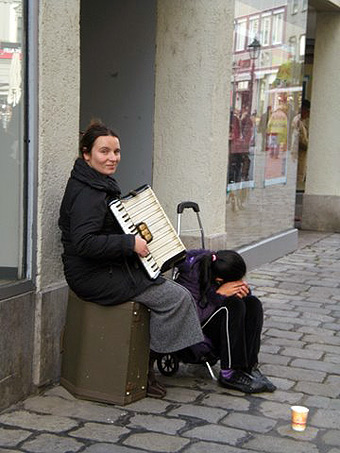 |
 |
|
 |

|
Augsburg
Story and photos by Corinna Lothar
Here you can you find the world’s oldest stained glass windows, and Europe’s oldest social housing project, and the family roots of Wolfgang Amadeus Mozart. Lovers of Mozart, in fact, can follow his trail from Augsburg for a hundred miles to Salzburg for the annual festival of Mozart operas. It’s easy to reach by automobile or train.
Augsburg is the third city of Bavaria, the second oldest city in Germany, founded in 15 B.C. by the Roman general Drusus, the stepson of Roman Emperor Augustus. Drusus set up a military camp on the rolling hills between the Lech and Wertach Rivers and the encampment grew into a town, with a marble temple, a tribunal and a castle, which the Romans called Augusta in honor of the emperor. The Italians still call the town by that name, but the Germans renamed the Bavarian city, Augsburg. Augsburg continued to play an important part in the Holy Roman Empire during the Middle Ages. The city is not all the pursuit of pleasure. This is where, in 1518, Martin Luther was summoned to recant his 95 theses before a papal emissary. He refused, and the Reformation followed. In 1555, the Peace of Augsburg, separating the Protestant and Catholic churches in the Holy Roman Empire, was signed in Augsburg. The Peace gave citizens the right to choose between the two religions. Augsburg became a center of the Lutheran creed. During the 15th and 16th centuries, Augsburg was one of Europe’s wealthiest communities, primarily because of its textile industry and the political and financial power of its banking families. Chief among these were the Fuggers. In 1521, Jakob Fugger the Rich established an unusual legacy. He built a small city within the city of two-story row houses, each containing two apartments. The Fuggerei, as it was called, consisted of eight streets and seven gates. It had its own walls and church. Each of the original 110 housing units had a private entrance, and each apartment had a chimney. The downstairs apartment opened on to a small garden, while the upstairs apartment had an attic.
Renters paid only one guilder a year, the equivalent of about 50 cents. To qualify, residents had to be destitute through no fault of their own; they had to be Catholic and citizens of Augsburg; and they were obligated to pray daily for their benefactors. This was sweet music to the lucky renters, and why not? The most prominent resident of the Fuggerei was the master builder Franz Mozart, the great-grandfather of the composer. Not much has changed in the intervening 450 years, except that it is the Fugger Foundation rather than the family which owns the Fuggerei, and it is the town council which determines who gets to live in the Fuggerei. Residents are still required to be citizens of Augsburg and to offer daily prayers for their benefactors. The rent remains the equivalent of one Rhenish guilder, or about $2 a year, but that doesn’t include utilities. Today, there are 150, mostly older, people living in 140 apartments in 67 buildings in the oldest social settlement in the world.
The Fuggerei is open for visitors. A model apartment, furnished as it would have been, shows how the inhabitants lived during the Middle Ages. During the summer months, a café inside the Fuggerei, located on the main square, serves light fare in a beer garden setting. A guide in medieval dress is stationed near the central fountain. During World War II, Augsburg, including the Fuggerei, was heavily damaged, but its core was rebuilt to look much as it had during medieval times. Today, 60 years later, it has acquired much of the patina of the original and has once again become a graceful town with a large central square, an imposing city hall, lovely churches, a charming market and numerous restaurants and cafes, many of them serving excellent German and Italian cuisine. Photographs of the damage to the Fuggerei and its reconstruction are exhibited in a small museum within the Fuggerei. The entrance to the museum is the house in which Franz Mozart resided. The Catholic heart of Augsburg is St. Mary’s Cathedral, where the 12th century stained glass windows are located in the south transept. The windows represent the Old Testament prophets Jonah, Daniel, Hosea and Moses and King David. Although small, when the sun streams through them, the windows are beautiful to behold. The cathedral was built from the 9th to the 14th centuries, primarily of red brick. Inside are five splendid altar paintings by Hans Holbein the Elder, one of Augsburg’s native sons. (The playwright and poet, Bertolt Brecht, is another native son, whose birthplace is now a museum.) It was built with square Gothic towers and its 11th century bronze doors, adorned with reliefs depicting a mixture of Biblical and mythological subjects, are now in the Cathedral Museum adjoining the cathedral. In the courtyard in front of the cathedral several Roman artifacts are displayed, including a large stone pinecone, the symbol of the city. The pinecone is thought to have been the regimental symbol of Drusus, the Roman general. It is found as a decorative element in several places around the city, including on one of the large gables in the front of the Town Hall. The basilica of Saints Ulrich and Afra -- actually two churches, one Catholic and the other Protestant – is worth a visit. The Gothic churches are named for Ulrich, a 10th century prince-bishop whose army assisted in the defeat of the Hungarians in the 955 Battle of Lechfeld, and Afra, a Roman virgin martyred in 304 A.D. Founded in 1321 as a Carmelite monastery, St. Anne’s Church was host to Martin Luther during his stay in Augsburg in 1518. His rooms have been turned into a small museum of the Reformation. A portrait of Luther by Lucas Cranach the Elder hangs in the eastern choir.
Augsburg’s city hall (the “Rathaus”), which Napoleon visited in 1805 and 1809, dates from the early 17th century. The building was the first in the world to be more than six stories high. Its outstanding feature is the two-story golden banquet hall with elegant doors, gold-leaf coffered ceilings and large wall paintings. The building was severely damaged by allied bombers in 1944, leaving the hall in ruins. It was rebuilt after World War II and now serves for important state and city functions. Next door to the golden hall are four “princes’ rooms,” used for smaller meetings. They are lovely wood paneled rooms, two on either side of the hall. The Rathaus is open to the public. For visitors with the stamina to climb the 258 stairs to the top of the Perlach Tower, next to the Town Hall, an ancient guard tower dating from 1060, there’s a great view of the city and the Maximilian Strasse (street) lined with elegant patrician houses. It is Augsburg’s elegant main shopping street.
The Schaezlerpalais is a splendid mansion, built as a private home by an Augsburg banker in the late 18th century. Teen-aged Marie-Antoinette stopped off for the night on April 28, 1770 at the Schaezler mansion on her way from Vienna to Paris for her marriage to the Dauphin of France. She danced the night away at a ball given in her honor in the mansion’s rococo ballroom. Today, the mansion houses the municipal and state collection of paintings. Most of the paintings are by German artists of the Renaissance and baroque periods, but along with Holbein the Elder and Durer works are Tiepolos and Rubens and other Renaissance masters. The Durer portrait of Jakob Fugger hangs in this museum. Augsburg’s Centre of Contemporary Art and the State Gallery of Modern Art, showing post 1950s American art, are located in the Glass Palace, an industrial monument made of iron, concrete and glass, which formerly was used as a weaving mill. Concerts and films are shown in the Glass Palace, which also houses, Magnolia, one of Augsburg’s fine restaurants. An Augsburg specialty is its children’s puppet theatre. Modern and classic fairy tales - Aladdin and the Forty Thieves, Rumpelstiltskin and The Little Prince – are performed at the Augsburger Puppenkiste . The marionettes are a delight to old and young, even to those who don’t understand German.
Augsburg has many excellent restaurants, preparing both Bavarian and international dishes. One of the most charming is a little restaurant in the center of town called Die Ecke (the Corner), where French and Swabian dishes are flawlessly prepared. Hans Holbein the Elder and Wolfgang Amadeus Mozart dined there. For good Italian food, try Milano or Tartuffo, both located in the center of town. August is a tiny restaurant serving excellent German food. Haupt is a restaurant located in the basement of the Prince Carl Palace, a 19th century military barracks. Bavarian specialties include white sausages served with pretzels and mustard (but only eaten until noon); pork roast with dumplings; spaetzle (mini noodles) in a rich cheese sauce; and goose with red cabbage and dumplings in November and at Christmastime. Wonderful rolls and dark bread and excellent pastries are available at the many bakeries throughout the city. Augsburg is well situated for day trips in the area. Munich is only 40 minutes away by train, or an hour by car. Lake Constance and the charming island town of Lindau are within easy driving distance.
Fuessen and nearby Neuschwanstein Castle are about 60 miles south of Augsburg in the foothills of the Bavarian Alps. The castle, built by “mad” King Ludwig II of Bavaria, was the inspiration for Walt Disney’s Cinderella castle. Fuessen is also close to the beautiful rococo Wieskirche (or Church of the Fields), an extravagant 18th century masterpiece located in an alpine meadow just off the Romantic Road which ends in Fuessen. Casanova would love it. WHEN YOU GO: United Airlines and Lufthansa service Munich from several U.S. cities. Once in Munich, it’s an easy train ride from the airport to downtown Augsburg. Trains run frequently from Augsburg east to Salzburg and Austria, north to Nuremberg, south to Garmisch and Switzerland and west to Stuttgart and France. Rail passes or single tickets can be purchased in the U.S. through RailEurope at 1-800-622-8600 or raileurope.com. For information on Augsburg, see Guide
to Augsburg and Stadt
Augsburg: A Visitors' Guide to Augsburg. |
I found a Mich Goss J. Grassmayr Innsbruck bell with Jesus,
a crucifix and a flower on it. Do you have any information about it you can
share with me? Many thanks. I don't have any information on that specific bell. If she wants information, "Liz" in San Bernardino should contact the factory. Here is the information: Address Grassmayr Foundry and Bell Museum, Leopoldstrasse 53, Inssbruck, A-6010 Austria. Telephone: 43 512-59416-0. Fax: 43 512-59416-22. E-mail: johannes@grassmayr.at or info@grassmayr.at. Corinna
Been there -- thought I'd done it -- you proved me wrong. Great travel coverage -- even for those who have lived there. --- Bill, Redmond, Oregon
Corinna, my dear, What a wonderful series of words you have collected together to paint a mesmerizing story about one of my favorite places. Even though I've traversed these same locales as you many times, your delightful descriptions made me want to book a flight this very second and see again some of the places that time did not allow me to linger in before. Your photos are also riveting, and I loved the pantyhose one - what a clever, sexy way to promote that article of the female form. Your colorful words make the entire region literally come alive before my eyes - a rare gift for any writer! Bravo and again Congrats on your top notch feature. Best regards. Best regards,
Hello Corinna, This is very roundabout ... I was recently teaching (Legal Reasoning) in Kabul and encountered Ann Geracimos, who said she knows you from the Times. She recently provided me with an electronic version of your 2007 piece about returning to Frankfurt (which I enjoyed very much). Jonelle and I are well (and enjoying our 3 grandchildren, who live within blocks of our house). I hope you are well. I will now look for your travel writing regularly. Best regards,
What an amazing background Ms. Lothar has! I enjoyed her article
very much. I found it to be quite intriguing, especially the interpreter school
bit.
I loved your article on Metz. I was an exchange student living there from 1981-1982 and have always felt like Lorraine was the most overlooked part of Europe. You really captured the feel of the city with your photo and articles.
|
![]()
Stay tuned.
This site is designed and maintained by WYNK Marketing. Send all technical issues to: support@wynkmarketing.com












